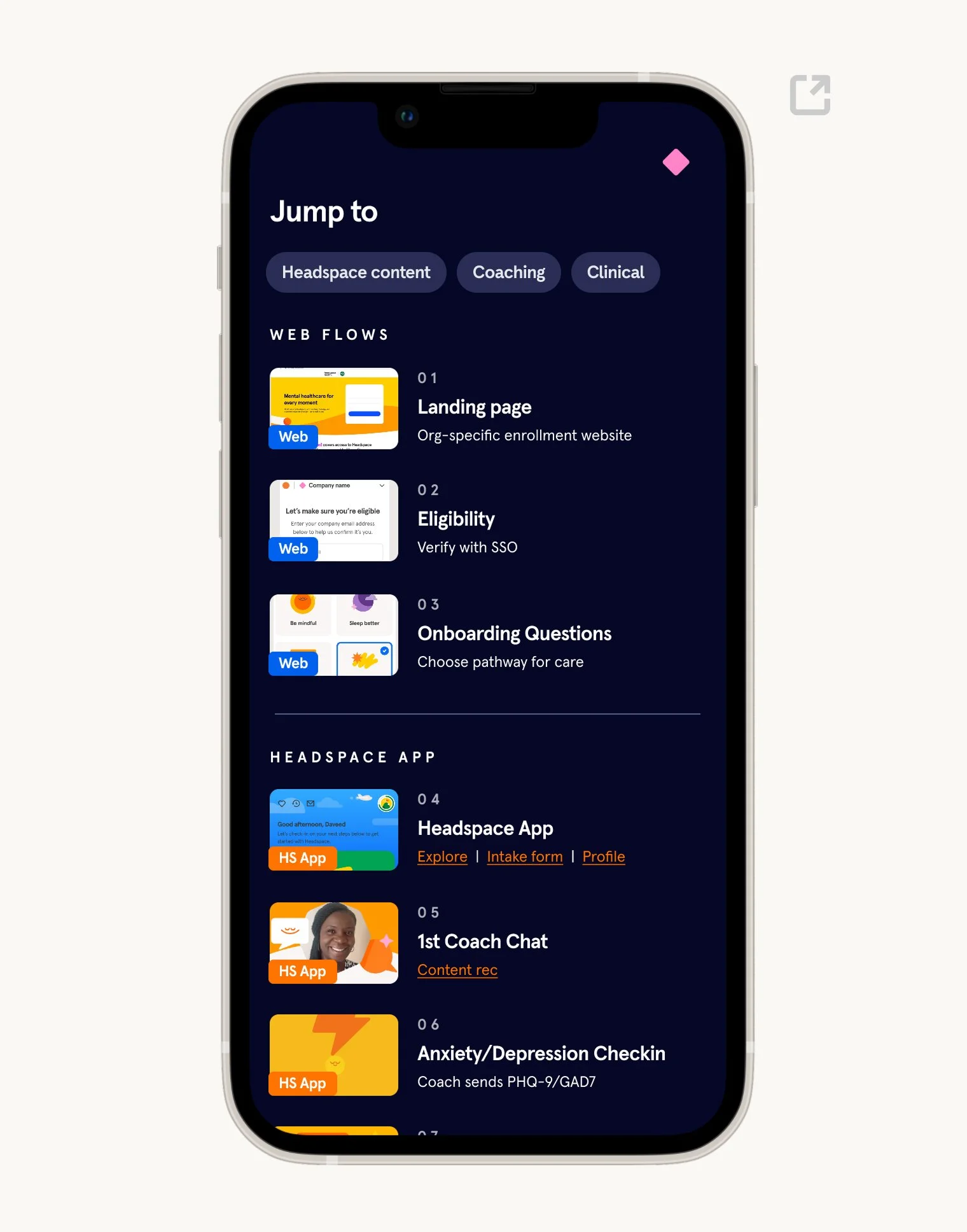Unifying the Headspace & Ginger app experiences
Design manager & IC | 6 month duration | Team of 125+
Key results
50+ closed enterprise deals
10x member enrollment rates
12% engagement increase
Delays in integrating Headspace and Ginger were undermining sales and weakening the merger’s value. Our goal was to launch a unified mobile app experience that would meet immediate market expectations and set a strong foundation for growth.
Context & challenge
Code-named, “Fusion,” this epic project sought to unify all Headspace and Ginger services in a new mobile app experience, without disrupting the underlying service architecture or legacy app compatibility.
Background
In October 2021, Ginger and Headspace merged to create a “holistic, scalable, and effective mental health and well-being company” serving 100M+ consumers. But with no defined product roadmap, disparate systems, and leadership churn - integration was slow.
Problem
As a temporary fix, we had bundled the apps under a single, web-based sign-up flow and loosely connected the apps using “side door” navigation and contextually placed links. The result: a fragmented brand and disjointed user experience that fell short of market expectations.
Challenge
Align the team around a clear “North Star” vision and deliver a redesigned, unified mobile app to attract and meet market expectations.
Our housing metaphor for transforming the Headspace and Ginger offerings. We moved from a Duplex to One Home during the Fusion project.
My role + responsibilities
As the most senior legacy Ginger design leader, I used my extensive knowledge of Ginger’s provider workflows and member experience to act as a bridge between the legacy Ginger team and our Headspace counterparts. My work spanned defining a shared product vision, ensuring human-delivered care needs were understood and prioritized, and leading the design of complex UX flows that would underpin our combined offering.
Shaping vision and selling the concept
Inspiration via storytelling
Early in the project, I contributed thought-leadership, storyboards, and low-fidelity screens to a VP-created deck that reimagined the future of the Headspace product ecosystem.
The deck inspired the team to move forward with unifying the apps and sparked the creation of a Figma prototype that served a critical business purpose: selling the “Fusion” concept to enterprise clients before the product existed.
The sales protoype
Designed by Lead Product Designer, Stephanie Nakamae, the prototype secured sales from 50+ enterprise customers months ahead of launch.
Design leadership across teams
Beyond vision work, I worked closely with Headspace design leadership to ensure our unified product accounted for the full range of care flows—not just the “happy path” scenarios that were part of the sales prototype. This included facilitating in-person work sessions, identifying scenarios, and diagramming undocumented service workflows.
In-person working sessions
I led a workshop to incorporate teen and health plan user edge cases into onboarding flows.
Service flow documentation
Designed flows to clarify non-happy path use cases.
Rebranding mentorship
I mentored a Senior Product Designer during the rebrand to ‘Headspace Care,’ guiding them on how to estimate the effort required to migrate existing screens into the Headspace design system, identify when unique components were needed, and batch deliverables to support faster, rolling implementation by engineering.
Cross-functional collaboration
I unblocked decision-making on our Fusion onboarding experience by designing four end-to-end flow options, outlining the pros and cons of each, and facilitating alignment among diverse stakeholders—including Legal, B2B/D2C Product, Care, and Engineering.
Mitigating risk through rough concepting
Merging the two apps also meant unifying Member Support, but the Ginger and Headspace MS teams used different tools—Listener for chat-based “legacy Ginger” requests and Zendesk for email-based “legacy Headspace” requests. Leadership wanted all requests in Zendesk to streamline training, QA, and reporting.
The problem was that Ginger’s chat system was deeply tied to product logic. Automated messages triggered key actions within the member app—like prompting members to complete intake forms during clinical escalations. Other situations required immediate, real-time help, such as fixing Zoom issues before therapy sessions.
To surface these challenges, I partnered with an engineer to document all automated chat messages, presented the challenges/opportunities to stakeholders, and mocked up potential solutions. The visuals helped us identify a number of issues that would take a significant amount of time and resources to address effectively. As a result, Product decided to delay tool consolidation until after the Fusion launch, mitigating against service disruption and overall member drop-off.
My documentation later formed the foundation for the post-launch support tool integration and member experience.
Outcomes & impact
50+
Closed enterprise deals
10x
Member enrollment
12%
Engagement increase
Lessons learned
The Headspace and Ginger merger taught me a lot about the challenges of bringing two different companies together - integrating cultures, ways of operating, legacy systems, and more. If I were to do it again at another organization, these are the things I’d want to keep top of mind:
Visual stories inspire action
When in doubt about how to move an idea forward, tell a visual story. A concrete prototype or storyboard gives others something to react to, far more effective than words in the ether. It’s one of the fastest ways to inspire alignment and unlock momentum.
Diagramming clarifies and connects
Service design diagrams and UX workflow maps are invaluable for onboarding team members across disciplines and reducing hidden risks, especially when merging legacy systems. Staying on top of this documentation as you go saves precious time later on.
Stress metrics and desired results
It’s easy to want to accelerate change across a product or organization when a major redesign comes about. You may be sitting on a great idea or even have finished designs ready. However, if the change doesn’t align with the primary goals of the redesign, it may introduce unintended consequences. Staying focused and sequencing change strategically is the best approach.




